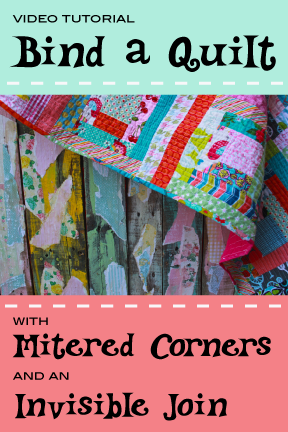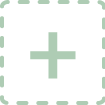Creating the Binding Strip
1
Begin by trimming off any excess batting or backing. You’ll need a nice, straight edge.
2
First we’ll make the binding. I prefer to start with strips of fabric that are 3 inches wide, but I have plenty of 2-inch strips left over from making the quilt blocks, so I’ve decided to use those instead. You can vary the length of the strips you use, but make sure they are all the same width.
3
Now we’ll attach the short strips into one very long strip. To do this, hold one strip vertically, pattern-side up. Lay the second strip pattern-side down on top of it at a right angle, with the loose end of the second strip going out horizontally to the left.
4
Sew together diagonally, stitching from the top left to the bottom right.
5
Trim off the excess corner fabric, leaving a ¼ inch seam.
6
Continue the process with the next short strip. You’ll need to create a strip that’s long enough to go around the perimeter of your quilt, plus about 2 feet extra to make sure you have enough for the corners and attaching the beginning and ending of the strip together.
7
When your strip is completed, fold it in half lengthwise, with the pattern on the outside. Press the entire length of the strip.
8
Now we’ll pin the binding strip to the top of the quilt. The binding strip should still be folded in half. Begin pinning along the middle of one side– don’t start at a corner. Leave a 5-inch tail before you begin pinning, we don’t want that part sewn yet because we’ll need to attach it to the other end of the binding.
Line up the raw edge of the folded binding with the raw edge of the quilt, and pin along the length of the side.
9
Sew the binding to the quilt with a ¼ inch seam, remembering to leave the beginning tail unsewn. Stop ¼ inch away from the corner.
Making Mitered Corners
Here’s how to achieve beautiful mitered corners on your quilt.
1
You stopped sewing the binding strip ¼ inch away from the corner. Pull the binding strip outward horizontally at a 90 degree angle so that it’s even with the bottom edge of the quilt. This creates a triangle-like fold. Place your thumb over the fold to hold it in place.
2
Then fold the strip back over itself horizontally, so that it is lying on the quilt top once again. The fabrics should line up evenly at the corner.
Line up the raw edge of the binding strip with the raw edge of the quilt. Pin the folds at the corner to secure.
3
Begin sewing from the
very top of the binding strip. (You do
not need to leave 1/4 inch as you did before the corner.)
4
Continue sewing down the length of the side with a ¼ inch seam, stopping 1/4 inch away from the next corner and repeating the previous steps.
5
You can see that if you turn the folded edge of the binding to the back side of the quilt, you’ll have a beautiful mitered corner.
6
Stop sewing about 4 inches away from the end of your binding strip, leaving a tail as you did in the beginning.
Attaching With an Invisible Join
An “invisible join” hides the beginning and ending of your binding strip by making it look identical to the rest of the binding.
1
You should have a tail where you began sewing your binding. Snip the beginning tail down to 3 inches. Save the scrap you cut off because we’ll use it as a measuring tool in a moment.
2
Fold the ending tail over the beginning tail, noting where they meet. Then measure out from that meeting point, using the width of the binding scrap you cut as your measuring tool. Mark this point, then cut your ending strip at that point.
(Since my binding strip is 2 inches wide, I am cutting 2 inches past the point where the fabrics overlap.)
3
Unfold the tails so they are flat. Hold the beginning tail vertically, pattern-side up, and lay the ending tail horizontally on top of it, pattern-side down, at a 90 degree angle. (In other words, right sides are together). This is similar to when we created our long binding strip.
4
Pin together, then sew diagonally from the top left to the bottom right.
5
Trim the excess fabric at the corner with a ¼ inch seam.
6
Fold this binding fabric in half to sew it to the top of the quilt, as you did the rest of the binding. You can see that this creates a join that looks identical to the rest of the binding.
Options for Finishing Binding
The last step is to attach the binding to the back of the quilt. This is done by folding the binding backwards and sewing along the edge of the binding, typically using a thread that matches the color of the binding.
There are several options for finishing the binding…
Machine Sewing (Stitch in the Ditch)
The first option is machine sewing. This is by far the fastest option, however, the stitches will show on the top side of the quilt. To machine sew, fold the binding backwards and sew from the top side, stitching in the ditch of the binding’s first seam.
Hand Sewing, Running Stitch
The second option is to handsew with a running stitch. This is a favorite of quilters because it’s possible to create very tiny stitches that are nearly invisible. However, it’s very time consuming.
To sew with a running stitch, go in and out horizontally with your needle, catching only the binding and backing of the quilt. Be careful not to go through to the front side of the quilt. Try to sew with tiny, uniform stitches, along the very bottom edge of the binding.
Hand Sewing, Whip Stitch
The third option is hand sewing with a whip stitch, which is the option I chose for this particular quilt. A whip stitch is typically faster than a running stitch, but is less tidy. It gives a quilt a handmade feel.
To sew with a whip stitch, poke the fabric through the backing of the quilt, then up through the binding, close to the edge. Poke back through the backing and repeat.
No matter which method you use, I recommend securing the fold at the mitered corners with a couple of hand stitches.
For more quilting tips, check out How To Make a Log Cabin Block, and How To Assemble a Block Quilt.



 Finished?
Finished?
I love your tutorials! You are so talented! I can hardly wait to make my first quilt which will be a log cabin quilt, thanks to your instruction. I just checked my fabric stash and I have quite a few scraps to start with. Wishing now that I had saved more fabric scraps. Oh well, live and learn.
Thank you! Wonderful quilt and clear as a bell instructions. I *am* going to try this as home!
Thank you for caring about a stranger. I appreciate your generosity in helping me learn skills that I never had time or money for while I was raising 5 children and then working and caring for parents.Again I am grateful.
Love your binding video. It is such a help. Question: when using 3 inch binding strips do you sew a 1/4 inch seam or 1/2 inch seam. Thank You
Bonny
And I’m wondering if I use a 3 1/2 ” binding and a 1/2 inch seam called for in quilt instructions, when I stop for the mitered corner, do I stop 1/4 inch from edge and or 1/2 inch?
Michelle
I dugg some of you post as I thought they were very helpful extremely helpful
I am dyslexic and has having such a difficult time with the corner for the first time that I actually walked away from my quilting project for a week. I stumbled upon YOUR video on youtube and I’m so happy now! I took my time and finished the binding part around my entire quilt in less that 20 minutes.
Thank you ever so much!